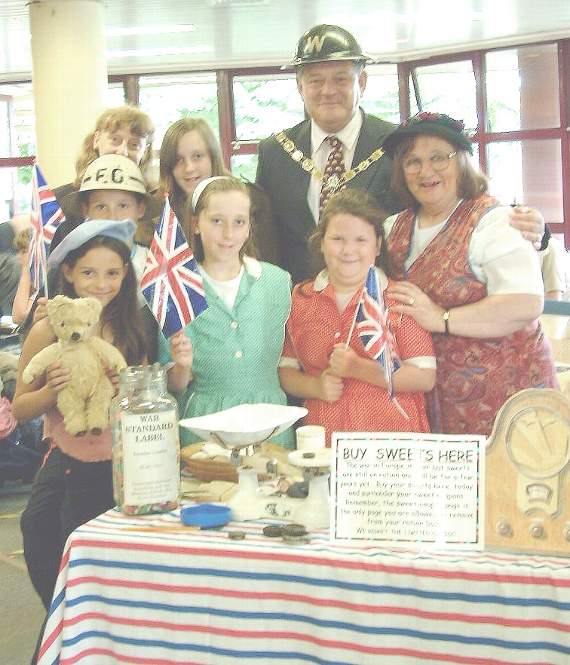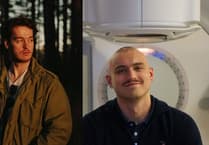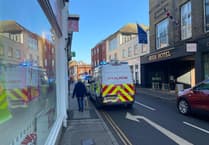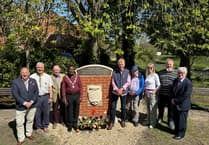PICTURE this scene in West Street, Farnham, close to The Wheatsheaf public house in the early 1980s: Jean Parratt is dressed in a tutu and carrying a sugar plum fairy’s wand in the shape of a star. She approaches a young police officer standing on the footpath and taps him on the shoulder with her wand. “Happy Christmas, officer,” she says, but his response is a little officious: “Do you mind, madam - I am on duty.”
In later years Jean became one of Farnham’s best-loved historians and writers and that she was awarded the MBE in 2004 bears witness to this talent and commitment to the town and its people.
In the fairy wand incident Jean, who died recently at her home in Roman Way, Farnham, aged 81, was a temporary fugitive from one of the parties arranged as a festive celebration for newspaper proprietor Ray Tindle at the offices of his newspaper, The Surrey and Hants News, at 104a West Street.
Jean was the title’s advertisement manager at the time, but was also ancillary reporter and photographer for its then editor, the late Guy Bellamy. She was often to be seen around the town with her throwaway camera and her fame grew when later she was a stalwart at The Museum of Farnham and over the years wrote 10 illustrated books about the town.
On the newspaper her colleagues referred to her among themselves as ‘The Oracle’, to mark her extensive knowledge of Farnham and its people.
Her previous experience with IPC (International Publishing Corporation) in the City of London and several years working on marketing magazines held her in good stead for what is now termed ‘networking,’ but even on the magazines she managed to combine work with fun.
One of her colleagues, James, an old Etonian, talked her into recording details of the pubs in the Bowling Green Lane area and piggy-backed her across Blackfriars Bridge on one occasion to ‘save her knees’ while gathering details.
Her museum work included the popular Saturday Museum Club, where she worked in concert with Rosalind Crowe, who performed to the children as the eccentric figure of Miss Tudge, the Victorian archaeologist, or as Florence Nightingale, while Jean would masquerade as Mrs ’omes, the Cockney market stall lady.
These performances and the educational trappings which both women brought to these sessions brought coachloads of schoolchildren to the museum.
In her early years Jean lived with her family in Brixton, London, and her first moment of fame came when she was featured, at three-and-a-half years of age, as the youngest air raid warden in Britain.
The South London Press reported that she assisted her father George Bowdery in his work as a warden and that she had attended a fundraising event with him intended to benefit the Belgrave Children’s Hospital in Kennington.
During the war years she was herself an evacuee, attending Meanwood School, Leeds, at the time and later Bromley High School and Farnham Girls Grammar School. The latter, situated in Menin Way, Farnham and now South Farnham School, gave rise to many more opportunities for talks and visits, through her membership of the Old Girls Association.
Later, during Jean’s work at the Museum of Farnham, she would often enjoy sleepovers with the children of Ash Walsh School, a natural undertaking for an experienced air raid warden, though a few years on, of course.
Once again she was in her element at these sessions, imparting first-hand knowledge to the children, the boys attired in WWII caps and the girls in dresses of the period. She also enjoyed the festive season at Farnham Museum, where she appeared as Mother Christmas, this character matching her generous nature as she presented each child who visited her in the cellar with a gift.
We married in May 1956 at Guildford Register Office and soon began life in an 18 feet-long caravan in Waddington, Lincolnshire, during my national service in the RAF. It was in Nocton Heath RAF Hospital, not far away, that Jean gave birth to our three children, two of whom remember the thumping of feet on the floor as our friend Terry Blackwell played his guitar to my guitar accompaniment. We lost our younger daughter, Deborah, in 2011.
In the 1970s Jean attended a further education class entitled ‘Widening Horizons’, conducted by Molly Saunders, a former headteacher.
Ms Saunders asked her class on one occasion if any had a particular hobby and Jean responded by showing her a Roman coin, a hussif (housewife), a tiny bag used by soldiers and other service personnel to retain needles and cotton to darn their socks, and a microlith and scraper, found near the Mesolithic site at Monkton Lane, Farnham.
“You should lecture about and show these items to others,” said Molly.” “With this hobby, you could enrich the knowledge and experience of many people.”
Jean often acknowledged her debt to Molly Saunders, who became a firm friend.
One unusual character who helped Jean with her talks was Mr Squeak, a slightly rickety pushchair on which she would pile her suitcases containing the artefacts for her talks, when I could not transport her in our car, and then the sound of the vehicle’s wheels (which seldom got a drop of oil) would squeak out as she rattled along the footpaths to nearby venues. Mr Squeak has survived and is still in our garden shed, but rust has immobilised him.
At about this time, Jean’s role as teacher, surrogate parent and friend to children found her at Park School in East Street, the former East Street School, where she proved of immense assistance to enlightened headmaster Dennis Kelly.
Forty years later, in The Borough, Farnham, she met a former pupil who had been the subject of much teasing at Park School because of his bright red hair. He said to her: “I have been a naughty boy since I left your school Mrs P, but meeting you again, I have decided to go straight.”
As a journalist, teacher, raconteur, researcher, lecturer, author and loving wife, mother, grandmother and great-grandmother, she brought interest and local relevance to the attention of adults and children alike.
Jean had also run Waverley’s Farnham-based playschemes in the 1970s and introduced her own versions of the schemes in the garden of our home in 2002, just before assisting me with my work on The Haslemere Messenger and The Alton Gazette and finally as my reporter/researcher on The Farnham Diary from 2004 until 2015. At these sessions, young members of the Trappitt family, who lived opposite our home, often referred to her by their nickname for her - ‘Jeano’.
No editor can have had such rich, locally-evocative copy as I had from Jean during those years, both as news and feature material. Meanwhile she was lecturing to children on her own account in schools over a wide area as well as to collectors’ and wives’ groups (and even to motorcycle clubs) with her Museum on a Shoestring, the artefacts of which we both carried into the lecture venues in a pair of suitcases.
We travelled far and wide, from the London area to Portsmouth, for these assignments.The talks included ‘Yesterday Once More’, ‘Farnham by The Wey’, ‘Goodbye Mummy’ (a WWII special), ‘One Foot in The Groove’, looking at the roots of recorded music and ‘Memories and Melodies’, a nostalgic romp through the golden greats of popular music, but performed afresh on a CD player, enhanced by Jean’s inimitable commentary.
I still have recordings of some of these talks, as well as her interviews with many Farnham personalities, including the late Annie Martin, whose Cockney street cries almost deafened the people of Farnham, radiating from the Martin family’s greengrocery stall at the foot of Castle Street.
She was a regular reader on the Talking Newspaper for the Blind for several years in the 1990s and she naturally brought professional flair to her delivery of key items re-read from local newspapers and then supplied to visually-impaired people on cassette tape or CD-ROM.
It was also in the 1990s that she found herself mentioned in the House of Commons. Passing Woolworth’s in The Borough, Farnham, on her way to meet a reader who had a story to impart, she saw Virginia Bottomley MP (later Secretary of State for Health in John Major’s government and now Baroness Bottomley of Nettlestone) getting out of her car, which was parked partly on double yellow lines outside Boots on the other side of the road.
Jean shouted to her: “No, Virginia, no - double yellow lines.” Virginia got back into her car and went to park somewhere less risky.
The next morning the MP, giving a brief speech to visitors to the Morning Room of the House of Commons said: “I might have been in legal trouble over parking, yesterday, but the head girl of Farnham saved me from that by shouting to me across the road that I was on double yellow lines.”
Jean’s qualities as author, journalist, lecturer and woman-about-Farnham combined to take her to Buckingham Palace in 2004 where The Queen awarded her the MBE for services to the people of Farnham.
Even there her eye was alert to the relevance of history and she made notes about the Victorian-style wooden ‘thunderbox’ (a toilet with nothing but a bucket as receptacle) which was still in use in the Buckingham Palace conveniences at that time and she further noted the darned carpets on the floors of the palace.
Her medical problems began in her first year of life. She was diagnosed with pyloric stenosis, a condition affecting the pylorus, a muscular valve in the stomach which, in some small children, produces projectile vomiting - the condition is considered life-threatening. The surgeon who operated on Jean had tragically learned much from an autopsy he had conducted on his own child and the procedure was successful.
In 2012 and suffering from increasingly serious heart valve disease, Jean’s aortic valve was replaced during life-saving open-heart surgery, but just a year later, she slipped on a drain cover and the resulting damage to her left foot meant that she had to endure several frustrating stays in hospital and she became increasingly house-bound.
Jean died suddenly of congestive cardiac failure at home on October 21, 2016. after a very happy day and lunch with me back in the centre of Farnham at our favourite pub, The Hop Blossom.
Many years before, she told me that she would like the words ‘SHE TRIED’ engraved on her headstone. Such typical self-deprecation was quite unnecessary, for Jean succeeded in so many ways, with great qualities of humanity, understanding and tolerance concerning her fellow human beings.
She will be remembered by all those have who benefited from her numerous talents, cultural interactions and friendships, but most of all by me, the husband she leaves behind.
In loving memory
Ted Parrat
• Herald proprietor Sir Ray Tindle said: “We are very sad to learn of the death of Jean Parratt. Jean was greatly involved with several of our newspapers over the years and was a respected member of the Tindle team. She will be very much missed by us all and by the people of Farnham.”





Comments
This article has no comments yet. Be the first to leave a comment.